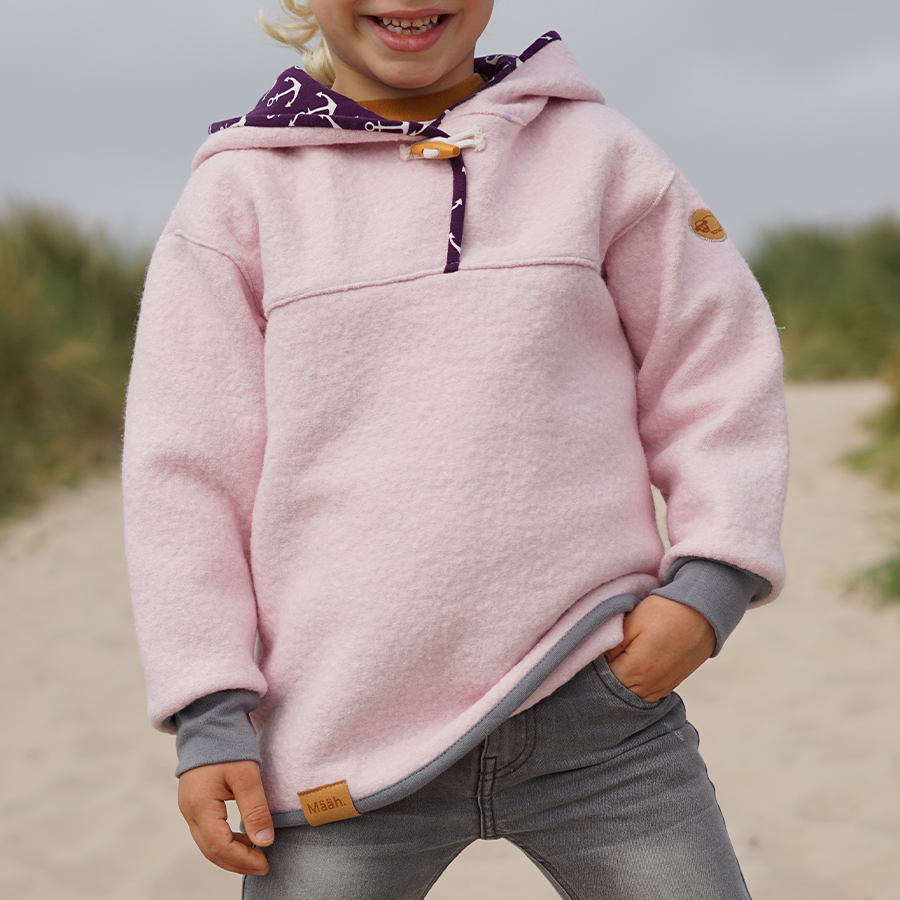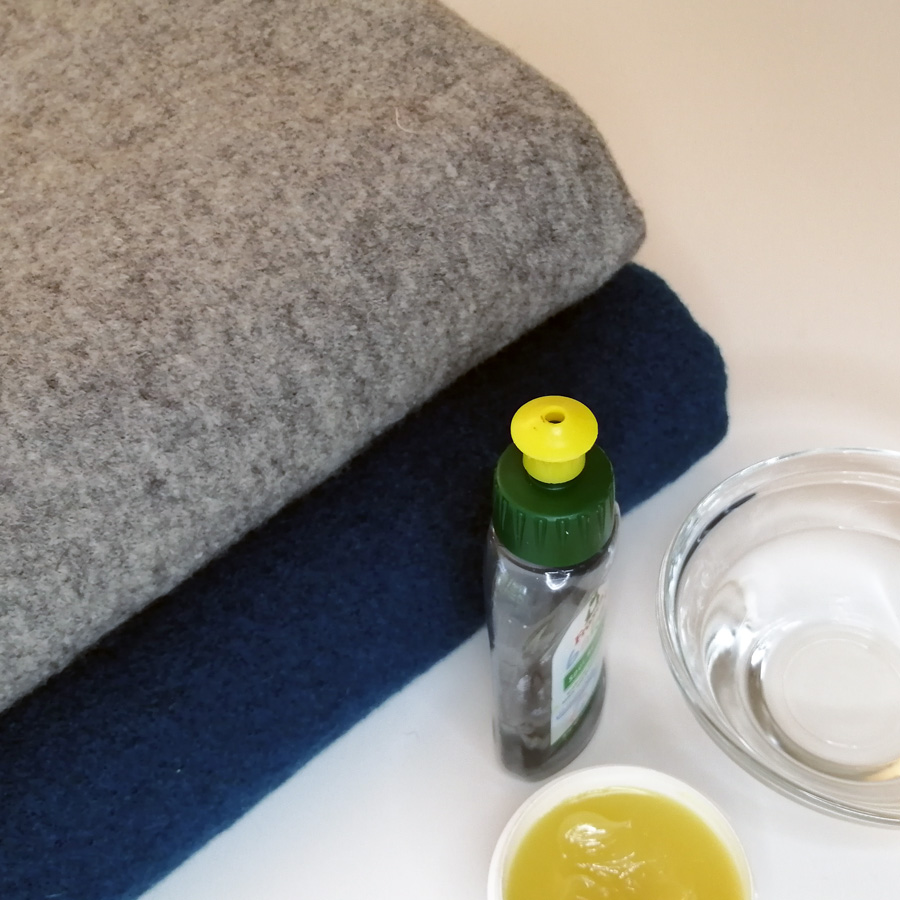Im ersten Blogbeitrag habt ihr ja schon einiges über Walk erfahren. Nachdem ich meinen Walk gewaschen habe, schneide ich ihn zu, lege mir alle wichtigen Materialen bereit. Ganz wichtig: bei mir darf die “Kuschellösung” vor dem Vernähen nicht fehlen 🙂
Before I sew up the fulling fabric after washing, I do one more step 🙂 The “soaking” in wool wax. I call it the“cuddle solution“. This makes the walk even more cozy and soft. At the same time, it becomes even more water-repellent. You can take this step, but you don’t have to. It is also often recommended to only use the softening solution after sewing, as there is a risk of the sewing machine becoming greasy. Fortunately, I have not yet had any negative experiences with it, although I always use the cuddly solution before sewing. If you want to be on the safe side, do it after sewing.
Depending on how many meters I have in one piece, I either insert the walk directly after washing. This saves me having to dry them. Or I let it dry, then cut it to size and insert the cut pieces.
You absolutely need pure lanolin for the cuddly solution. I have had the best experiences with the wool wax from Mystic Moments*. It smells almost odorless, is pure and has a great price/performance ratio.
Walk even softer and more robust:
You need the following ingredients for the cuddle solution :
– 1 teaspoon lanolin
– 1 teaspoon washing-up liquid
– 500 ml boiling water
This quantity is sufficient for approx. one child’s overall. If your garment is larger, simply double the quantities.

Put the lanolin, washing-up liquid and boiling water together in a container and mix well. Stirring takes a little time. It is important that the lanolin has completely dissolved (the detergent can dissolve the lanolin).
Then you need a large bowl or bathtub (depending on how much fabric you have to put in). Pour the solution into the bath and add some lukewarm water. IMPORTANT: no hot water. This was only important for dissolving the wool wax and would be too hot for the fabric.
You can then soak your fulling fabric in this mixture for approx. 12 hours. Mix by hand from time to time and make sure that all areas are covered with water. I often leave it in the bath overnight. Then gently squeeze out the whale and lay flat to dry. IMPORTANT: do not rinse again!
Depending on how much lukewarm water you have added, the whisk may feel a little greasy afterwards. This is correct and becomes less so as you wear them.
This will give you a softer and really robust walk afterwards.
The longer the fulling garment is worn and stressed, the less robust it becomes. Sometimes even airing is not enough, just a wash. Then you can wash the walk again as described above and, if necessary, make it robust again with the cuddly solution.
Here I would like to reiterate my stance against complete feeding from the first blog post.
If the jersey gets dirty, the garment can still only be washed in the wool wash program at 30 degrees. However, jersey needs higher temperatures to get it really clean (of course, it also depends on the degree of soiling). For me, that’s another argument why I prefer to only line the hood.
Treat lined whale pieces with “cuddly solution”:
Even if Walk is lined with a cotton fabric, the cuddly solution can still be used. But for me it feels somehow strange to soak a cotton fabric in lanolin. I have a little trick for that:
Pour the cuddly solution (diluted with lukewarm water) into a pump spray bottle and spray all unlined areas on the outside and inside. This definitely helps a little, even if it is not quite as intensive as the complete soaking.
Where do I buy the walk?
Some people wrote to me after my first blog post and asked me where I buy my walk. I would like to make up for this 🙂 I buy my Walk from various dealers. Depending on which color I need at the time. I buy most of my wool and fleece fabrics from my small local wool fabric retailer. I like the walk from Stoffe.de* online. I find it very pleasant. If you like, you can also order a sample in advance.
Can I also sew any pattern out of wool?
No, not every pattern is suitable for Walk. With jackets, it is important that the sleeves in particular are wide enough so that you can put the jacket on easily. If you would like to sew pants from fullers, the trouser cut should also be correspondingly wide. In the product description of my patterns you will find information on which fabrics the pattern is suitable for. If one of my patterns can also be sewn from fullers, you will find special fitting instructions for fullers in the eBook. The Luften bloomers, for example, also look really great made from Walk. If you would like to sew the breeches on the leg with elastic instead of cuffs, you can find the right sewing tutorial here. Since you asked so much for a Luften for older children and teens last year, the Luften bloomers are now also available for sizes 122-170. You can also sew the large airy breeches out of fullers.

For example, you can sew the Hej Varmen outdoor hoodie to go with the walker pants. I developed the pattern especially for fulling fabrics. But other thick fabrics are also possible with this cut. You can get Hej Varmen in sizes 56-122 and Hej Varmen Gr. 128-170.

What should I use to cut the walk?
I mainly cut Walk with my rotary cutter*. As Walk is quite thick, it is important that the blade is as sharp as possible. The blade is too blunt at the latest when the walk drags more “fluff” with it when cutting. I prefer to use sharp fabric scissors for smaller corners. As the scissors can become blunt from the fulling, I have my own scissors for fulling, which I then no longer use to cut jersey. It doesn’t always have to be expensive fabric scissors. Drugstores often sell larger household scissors that are also good for cutting fabrics.
The great thing about Walk is that it doesn’t roll when cut.

Which needle for Walk?
Walk is best worked with ball-point needles. As they are not so sharp, they cannot damage the walk as quickly. The round head allows them to glide easily through the walk. Theoretically, universal needles would also be conceivable. However, these are somewhat sharper, could damage the walk and also wear out quickly due to the walk. I have had the best experiences with these medium-weight jersey needles from Schmetz*. Have a few more ready to be on the safe side. Because even they can sometimes break off.
It is also worth having 1 or 2 twin needles* . I also use the Schmetz twin needle with a ball point. With a twin needle you can use a very special sewing technique after sewing together. More on this in my third blog post.
Staples or pins?
Walk is very thick and as soon as there are two layers on top of each other it becomes difficult to fix them with a pin. I prefer to use these Wonderclips*.
Which yarn?
As with many sewing projects, a high-quality polyester yarn is best suited for Walk.
How to transfer markings to Walk?
I have had the best experience using tailor’s chalk to draw markings on Walk. It is important that it is as pointed as possible. The tailor’s chalk can easily be rubbed out again afterwards. Over the last few years, I’ve become a real fan of this pen with chalk*. I use this not only for Walk, but also for my other sewing projects. I can hold it well in my hand and it is always a bit “pointy”.
Now you can cut your walk to size, insert it into the cuddly solution and you’re almost ready to go. In the next blog post I will show you special seams for Walk. You will also learn tricks and interesting facts about sewing with wool.
* The links marked with an asterisk (*) are so-called affiliate links. If you click on such an affiliate link and make a purchase via this link, I will receive a commission from the online store or provider in question. The price does not change for you.
